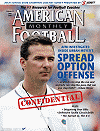AMERICAN FOOTBALL MONTHLY THE #1 RESOURCE FOR FOOTBALL COACHES
Article CategoriesAFM Magazine
|
Improving Your Running Gameby: Mike Leiderman© More from this issue The commitment to run the ball has to start when a head coach lays the foundation for his system. Portland (OR) State’s Tim Walsh sees this mentality as key to any coaching staff. “Coaches have to find a way to instill a belief in their players that they can run against anybody. At Portland State, we’ve created a mindset for players over several seasons.” Walsh and his assistant coaches stress the team’s prior success to new recruits, while returning players have already been in the system and experienced the results. US Military Academy OC Kevin Ross draws a parallel between the goals of his team and the institution it represents. “We’re going to have a good running game because we represent The Army. The Army is made up of a bunch of tough soldiers and we have to be tough, too. We want to lin....The full article can only be seen by subscribers. Subscribe today!
|
|
|||||||
| HOME |
MAGAZINE |
SUBSCRIBE | ONLINE COLUMNISTS | COACHING VIDEOS |
Copyright 2026, AmericanFootballMonthly.com
All Rights Reserved





